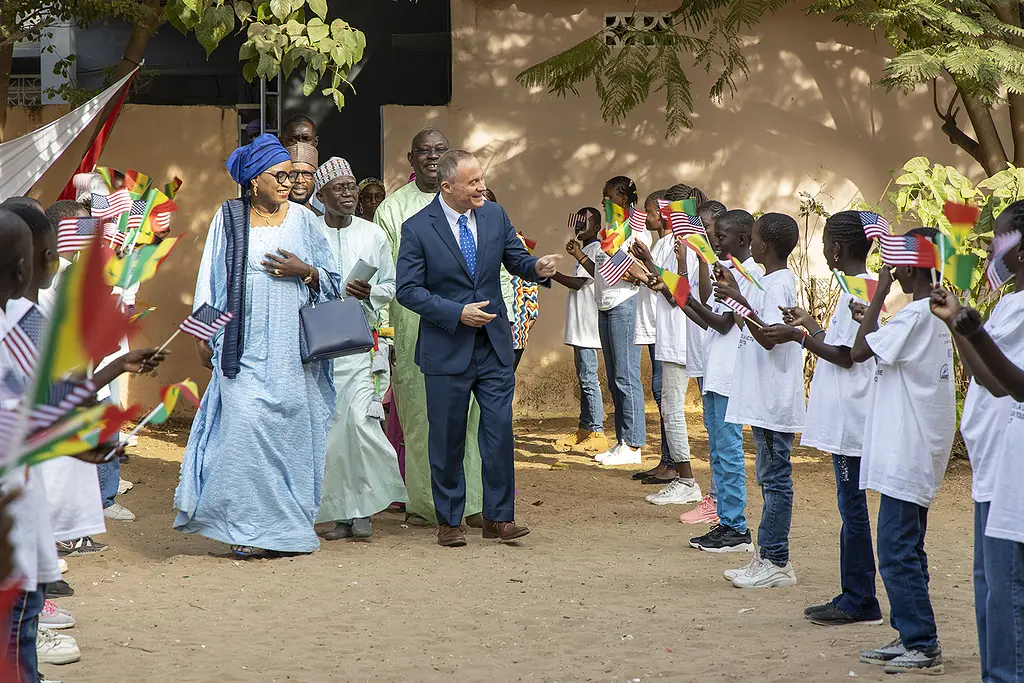
U.S. Ambassador to Senegal Mike Raynor and Secretary General of Senegal's Ministry of National Education Khady Diop Mbodji greet students during a handover of educational materials in Dakar. Photo by Patricia Esteve for RTI International
When some development practitioners think about locally led development (LLD) in the context of the U.S. Agency for International Development’s (USAID) renewed focus on localization, what first comes to mind is preparing local partners to directly receive development assistance. However, in the education sector, an increased investment by USAID in another form of LLD has been showing promise over the past decade: Government-to-Government assistance (G2G). Between 2010-2013, USAID “increased funding to partner country government institutions by almost 50%” in the education sector, and the current administration’s localization agenda suggests that the G2G modality may become even more commonplace.
G2G assistance is where, after careful vetting, USAID directly supports a country’s government institutions, which manage the implementation of US Government funding within their own systems. This form of LLD shifts power to host governments, creating an avenue for governments to directly shape the development assistance provided them. This avenue builds their institutional capacity while delivering the services envisioned by their national development plans. Alongside G2G assistance, implementing partners are at times engaged by USAID to provide technical and implementation support.
In Senegal, the Renforcement de la Lecture Initiale pour Tous program (RELIT) is the government’s ambitious early grade language program, which forms part of its national reform of bilingual education. It is implemented by the Ministry of Education (MOE), supported by USAID G2G assistance, together with RTI International, under a cooperative agreement that includes Associates in Research and Education for Development (ARED) and Save the Children. RELIT is an example of how G2G partnership can effectively work to deliver sustainable results.
Scaling education reform in Senegal with RELIT
Under RELIT, full-scale rollout of the national bilingual education program through USAID G2G assistance is being expanded from one region, where it was successfully piloted by a preceding program, to seven regions. National and regional branches of the MOE lead and deliver program implementation technically and financially in these seven regions, with technical assistance from RTI. RTI and its partners deliver the program in three other regions, while more broadly supporting the Government of Senegal to strengthen its capacity and build systems to support bilingual education. Full expansion of the program to Senegal’s three southern regions (Casamance), will be supported by the World Bank. For these remaining regions, the government and RTI have carried out preparatory activities, such as language mapping, community consultations, and materials development for the region’s primary language (Diola).
From the start, RELIT has been designed to work through and for Senegal’s education system, aligning the implementation of both assistance mechanisms to the planned expansion of reform of bilingual education, and with the goal of enhancing sustainability by positioning interventions and innovations within existing ministry structures. What does this mean for the role of USAID’s implementing partners? How does this change our approach to program implementation?
Key principles for effective G2G assistance implementation
In reflecting on our work in Senegal over the first two years of RELIT and building on lessons learned with similar G2G partnerships RTI has had in Nepal and Jordan, we’ve identified four key principles for leveraging G2G assistance. These principles help ensure that G2G assistance not only contributes to achieving the program's results, but also improves sustainability through building stronger government systems. We share these principles here to further the conversation around approaches to locally led development.
1. Adopt a service mindset
Playing a supporting role as an implementing partner requires an acknowledgement that there are multiple ways of knowing and doing things. We must have the perspective that we work under the direction of the host country government and everything we do needs to contribute to its leadership of changes. For example, at the start of the RELIT program, joint technical working groups led by MOE counterparts were established to co-create work plans and jointly monitor implementation and progress. Through this type of working relationship, the program is able to respond to needs expressed by the MOE and find innovative ways to address systemic barriers that impede their delivery of quality education.
2. Learn by doing together
The technical expertise and support an implementing partner provides cannot be transactional; rather, we need to work side-by-side with our local government counterparts to implement together. They deeply understand their systems and what will – and won’t – work, while we bring specialized expertise and global experience that gets adapted to the local context. At the start of RELIT, MOE officials in each region worked with RTI to identify policy and practice gaps that could impede successful implementation of the bilingual program and created institutional capacity building plans to address them.
RTI supported this process by introducing a self-assessment process—the Core Functions Capacity Assessment Tools—developed and refined elsewhere but adapted for Senegal alongside the same MOE partners. Subsequently, instead of RTI addressing the capacity building needs through stand-alone or one-size-fits-all approaches, the MOE and RTI are working through a leadership development process wherein the MOE is in the position of determining the best way to address gaps within their areas of responsibility.
3. Take a flexible, adaptive approach
Being responsive to the MOE’s needs requires being prepared to pivot from originally planned approaches. Learning by doing—together—has also created space for leveraging the expertise of regional and national government entities in addressing issues as they arise and building solutions into our joint work plans.
One way this played out early in our collaboration was that, at the request of the MOE, our support has touched upon all aspects of bilingual language development, including oral language and writing, rather than solely on the reading portion of the national language arts curriculum, as originally anticipated. When the MOE requested our additional help with the language aspects of the math curriculum as well, we consulted with USAID and were able to take on this additional workstream by making our staff available to the MOE.
In addition, given increasing demands for national language experts to participate in the design of teaching and learning materials and assessments, and delivery of teacher professional development, our Senegalese partner, ARED, is creating a resource network of language and pedagogy specialists available to the MOE for the math, science, and social science portions of the bilingual curriculum. This network will outlast RELIT and continue to serve as a long-term resource for the MOE and other donor-supported programs in Senegal.
4. Invest in relationships
It can be easy to forget that the government departments, programs, and actors we work with have many other competing demands outside of RELIT. Working in sync with Senegal’s MOE has required changes to how RELIT operates, including through adjusting expectations and timelines. Making time and space to invest in relationships and trust building between implementing and government partners has also been key.
In support of this, and at the request of the MOE, RTI hired an individual who serves directly as the G2G liaison to the MOE’s director of elementary education. This individual spends more than half his time at the MOE, with other RTI staff spending at least two days each week with their counterparts, while two other RTI staff are embedded in each of 9 regional offices. Working this way has built alignment in real-time delivery of RELIT’s mandate, proactively ensuring that RELIT activities are integrated into workplans and budgets, with the MOE in the lead, ultimately resulting in time well spent to deliver quality results, with capacity and sustainability built along the way.
Locally led development that goes beyond traditional aid
Senegalese officials who collaborate on RELIT describe the program as an MOE capacity enhancement initiative rather than a traditional education improvement project. With the MOE in the lead and the RTI consortium playing a supporting role, we are increasing the likelihood of long-lasting improvements to Senegal’s education system. This capacity building for improved delivery, including changes to policies and practices that ensure their bilingual reform, is, in the words of the MOE, “irreversible.”
Use of USAID G2G assistance on RELIT is an example of an approach to LLD that has the real potential to yield sustainable outcomes as it supports system change led by system actors. This model requires a new mindset by donors, host governments, and implementing partners that genuinely embraces the principles of cooperation and collaboration to address the priorities that governments have identified for themselves.

